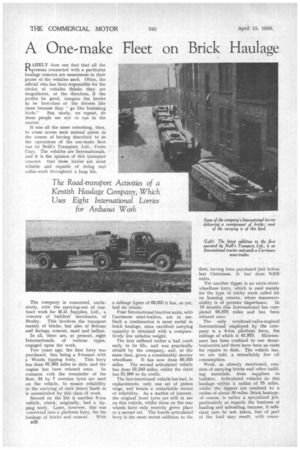A One-make Fleet on
Page 46

Page 47

If you've noticed an error in this article please click here to report it so we can fix it.
Brick Haulage RARELY does one find that all the persons connected with a particular haulage concern are unanimous in their praise of the vehicles used. Often, the official who has been responsible for the choice of vehicles thinks they are magnificent, or the directors, if the profits be good, imagine the lorries to be first-class or the drivers like them because they " go like humming birds." But rarely, we repeat, do these people see eye to eye in the matter.
It was all the more refreshing, then, to come across such mutual praise in the course of having described to us the operations of the one-make fleet run by Neill's Transport, Ltd., Foots Cray. The vehicles are Internationals, and it is the opinion of this transport concern that these lorries are most reliable and capable of doing real collar-work throughout a long life.
The company is concerned, exclusively, with the carrying-out of contract work for M.D. Supplies, Ltd., a concern of builders' merchants, of Bexley. This involves the transport mainly of bricks, but also of flettons and facings, cement, sand and ballast.
In all, there are, at present, .eight Internationals, of various types, engaged upon the work.
Two years ago, the first lorry was purchased, this being a 3-tonner with a Woods tipping body. This lorry has done 67,263 miles to date, and the engine has been rebored once. In common with the remainder of the fleet, 34 by 7 oversize tyres are used on the vehicle, to ensure reliability in the carrying of such heavy loads as is necessitated by this class of work.
Second on the list is another 3-ton vehicle, which, originally, had a tipping body. Later, however, this was converted into a platform lorry, for the haulage of bricks and cement. With B36 a mileage figure of 69,358 it has, as yet, had no rebore.
Four International tractive units, with Carrirnore semi-trailers, are in use. Such a combination is most useful in brick haulage, since excellent carrying capacity is obtained with a comparatively low unladen weight.
The first suffered rather a bad crash early in its life, and was practically rebuilt by the company, and, at the same time, given a considerably shorter wheelbase. It has now done 60,355 miles. The second articulated vehicle has done 55,243 miles, whilst the third has 51,800 to its credit.
The last-mentioned vehicle has had, in replacements, only one set of piston rings, and boasts a remarkable record of reliability. As a matter of interest, the original front tyres are still in use on this vehicle, whilst those on the rear wheels have only recently given place to a second set. The fourth articulated lorry is the most recent addition to the fleet, having been purchased just before last Christmas. It has done 9,315 miles.
Yet another tipper is an extra-shortwheelbase lorry, which is used mainly for the type of tricky work called for on housing estates, where manteuvr ability is of premier importance. In 18 months this International has completed 06,878 miles and has been rebored once, The only overhead-valve-engined International employed by the company is a 4-ton platform lorry, the mileage of which is 41,975. Maintenance has been confined to one decarbonization and there have been no costs for repairs to date. The vehicle has, we are told, a remarkably low oil consumption.
Work, as already mentioned, consists of carrying bricks and other building materials, from suppliers to builders. Articulated vehicles do this haulage within a radius of 75 miles, whilst the tippers are confined to a radius of about 30 miles. Brick haulage, of course, is rather a specialized job, particularly as regards the business of loading and unloading, because, if sufficient care be not taken, loss of part of the load may result, with conse quent complaint from supplier or receiver.
Quite a .arge part of the work takes the drivers north of the Thames, and it is found that, at times, these journeys suffer considerable delay, owing to slow progress through the Blackwall Tunnel. The company considers that great economy and convenience will be realized in its business if the proposed Dartford Tunnel materializes.
When the concern was first in operation, it was customary to carry 5,000 bricks on each of the articulated vehicles, but the maximum number has now been reduced to 4,500.
Routine maintenance is carried out by the company on a simple system. Vehicles are checked over every night by skilled mechanics, but a great deal of the onus of reporting suspicion or evidence of trouble is on the drivers, all of whom have a good understanding of mechanical matters generally. They are .not, however, required to carry out repairs, although they are
responsible for washing down the lorries.
No .vehicle is kept as a reserve, but it is the intention of the company to keep a complete engine ready for substitution in emergency.
The director of the company is Mr. V. Manchee, who keeps in close contact with the employees, takes an enthusiastic interest in all aspects of the transport industry, and, himself, occasionally drives one or other of the vehicles.




















































































